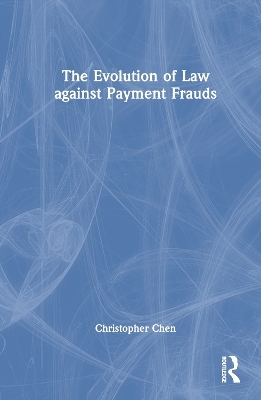
The Evolution of Law against Payment Frauds
Routledge (Verlag)
978-0-367-62436-1 (ISBN)
In the past century, the payment system has invited much innovation, changing the modes of payments from exchanging cash and coins to the use of cards, wire transfers and other new types of payment instruments or services (e.g. bitcoins or QR code payments). As the nature of payment services is to move money from one place to another, it naturally attracts fraudsters. Even with advanced computer technology, payment fraud is still rampant in the market, causing billions of dollars in losses globally per annum. Through an examination of payment instruments and associated frauds over time, the book illustrates a shifting trend of legal solutions from criminal sanctions and civil compensation to a gradual focus on regulations of payment intermediaries. This trend reflects the complexity of payment systems and the challenge of protecting them. The book also identifies the underlying actors and institutional characteristics driving the evolution of legal institutions to deal with payment fraud and illustrates how the arrival of new technology may affect the market and thus the evolution of legal institutions.
The book will help readers to better understand the interaction between technology, the market and law and help regulators, financial institutions, practitioners and end users, as well as about payment fraud and corresponding legal responses.
Christopher Chen is Associate Professor of Law at the College of Law, National Taiwan University.
List of Abbreviations
1 Introduction: The Interaction of Law, Technology and the Payment Services Market
Prologue
I. General Framework: Technology, Market and Institutional Change
II. An Overview: The Interaction of Technology, Financial Services and Fraudulent Activities in the Payment Market
A. Payment Process and Payment Services
B. Technology and Provision of Payment Services: From Physical to Digital 6
C. Technology and Fraud
D. Legal Institutions on Payment Services and Fraud
E. Summary
III. Interested Parties in Adopting Payment Technology and Countering Fraud
A. Regulators and Lawmakers
B. Financial Institutions
C. Telecommunication Firms and Internet Service Providers
D. Other Technology Firms and Start-Ups
E. End Users and Fraudsters
IV. Map of the Book
Reference
2 An Overview of the Evolution of Payment Services and Fraud
I. Introduction
II. Overview of Payment Instruments and Services
A. Basic Scenario
B. Cash: Coins and Notes
C. Negotiable Instruments
D. Card-Based Payment
E. Wire or Inter-Bank Transfer
F. Informal Money Transfer
G. Electronic Payment Services
H. Cryptocurrencies
I. Obstacle to Cross-Border Payment
J. Summary
III. Payment Fraud: A Broad Overview
A. Defining Fraud
B. Why Is Fraud Wrong?
C. Mechanics of Payment Fraud
IV. Chapter Summary
Reference
3 From Metal to Paper: Fraud Related to Cash Notes and Coins
I. Introduction
II. Cash Payment Fraud
A. Producing Counterfeit Money
B. Using Counterfeit Money
III. Legal Institutions Against Cash Fraud
A. Criminal Sanctions Related to the Production of Counterfeit Money
1. Criminal Sanctions for the Production of Counterfeit Money
2. Possessing or Making Tools or Materials for Counterfeit Money
B. Criminal Sanctions Related to Possession, Transport and Use of Counterfeit Money
C. Control Over the Issuance of Money and Security Features
IV. Summary and Reflection
Reference
4 Fraud in Paper-Based Negotiable Instruments
I. Introduction
II. Types of Fraud Related to Negotiable Instruments
A. Forgery or Alteration of Negotiable Instruments
B. Imposters: Unauthorised Issuance or Transfer of Negotiable Instruments
1. Unauthorised Issuance of a Cheque
2. Unauthorised Use of Personal Stamps
3. Fake Signature of Issuer
4. Fake Signature for Endorsement
C. Using Fake Negotiable Instruments
D. Issuance of Cheques With Insufficient Funds in a Bank Account
1. Issuing a Blank Cheque With No Intention to Meet Payment
2. Making a Payment With a Genuine Cheque but With Low Credibility
G. Summary
III. Legal Institutions Against Fraud Related to Negotiable Instruments
A. Criminal Sanctions for Forgery or Alteration of Negotiable Instruments
1. Forgery
2. Making or Possessing Tools or Materials to Forge or Alter a Negotiable Instrument
3. Criminal Sanctions for Using or Possessing Forged Negotiable Instrument Documents
4. Summary
B. General Fraudulence: Penalties for Issuance of a Negotiable Instrument With Insufficient Funds
C. Control Through the Banking and Clearing System
1. Customer or Chequing Account Agreement
2. Automated Clearing of Cheques
3. Security Features on Cheques
D. Civil Laws Regarding Negotiable Instruments
1. Signature by the Issuer
2. Crossing Out or Parallel Lines
IV. Summary and Reflection
Reference
5 The Evolution of Fraud Related to Card-Based Payment
I. Introduction
II. Types of Fraud Involving Cards
A. Counterfeit Cards
1. Cloning a Credit or Debit Card
2. Forgery or Alteration of Stored-Value Cards
3. Acquiring Counterfeit Cards and Forging Signatures
B. Using a Counterfeit Credit Card
C. Unauthorised Use of Cards
1. Unauthorised Use of a Person’s Credit Card With Correct Information
2. Unauthorised Use of Another Person’s Card With a Forged Signature
3. Unauthorised Use of Another Person’s Stored-Value Card
D. Acquiring a Credit Card With False Information
E. Fraud in Relation to Card Systems
F. Summary
III. Legal Institutions Countering Card Fraud
A. Criminal Sanctions on Payment Card Fraud
1. Criminal Penalty for Forgery of Cards
2. Criminal Sanctions for Using Forged or Altered Cards
3. Criminal Sanction on the Illegal Acquisition of Card Information
B. Anti-Fraud Mechanisms Adopted by Card Issuers
1. Security Measures by Card Associations
2. Banking Regulation on Credit Card Fraud Control
3. Self-Regulatory Rules on Banks’ Conduct
4. Regulation for Stored-Value Cards
C. Responsibility of Cardholders
1. General
2. Terms and Conditions for Credit or Debit Cards
3. Terms and Conditions for Stored-Value Cards
IV. Summary and Reflection
Reference
6 From Physical to Digital: Fraud Related to Inter-Bank Transfer and Electronic Payment
I. Introduction
II. Types of Fraud Related to Electronic Payment
A. Imposters: Unauthorised Inter-Bank Transfer
1. Unauthorised Bank Transfer in a Bank Branch
2. False Payment Instruction Made Remotely
B. Imposters: Unauthorised Remote Payment With Payment Cards or e-Wallets
1. Unauthorised Transfer by Bank Card
2. Unauthorised Use of Credit Cards Electronically
3. Unauthorised Access to e-Wallets
4. Unauthorised Transfer by Misusing Computer
Records
C. Insufficient Fund
D. Fraud by Unauthorised Payee
E. Fraud for Informal Money Transfer
F. Summary
III. Legal Institutions Countering Payment Fraud Involving Electronic Transfer
A. Criminal Sanction Against Abuse of Electronic Payment System
B. Regulation of Banks, Payment Services Providers and Payment Systems
1. Banking Regulation on Wire Transfer Regarding Fraud
2. Regulations Specifically for Non-Bank PSPs
C. Contractual Approach to Control Fraud
1. Regulating End Users’ Conduct
2. Regulating Merchants’ and Payment Services Providers’ Conduct
3. Contractual Arrangements for Losses due to Fraud
4. Liability Rule and Fraud
IV. Summary and Reflection
Reference
7 The Future: Payment Fraud in Digital Payment Tokens
I. Introduction
II. Crypto Payment Fraud
A. Counterfeit Digital Payment Tokens
B. Unauthorised Transactions
C. Fraud by Unauthorised Payee
D. Insufficient Funds?
E. Summary
III. Legal Institutions: Evolution for Digital Payment Tokens
A. Potential Criminal Sanctions Against Fraud Regarding Digital Payment Tokens
1. Misuse of Computers
2. Forgery and Counterfeit: Recharacterisation of Digital Payment Tokens
B. Regulation of Payment Service Providers for Digital Payment Tokens
1. Self-Regulation or On-Chain Governance
2. Regulation of Crypto-Wallet Providers
C. Contractual Arrangements and Fraud
IV. Summary and Reflection
Reference
8 Reflection and Conclusion: A Shifting Trend of Anti- Fraud Legal Institutions
Recap of Previous Chapters
I. Reflection I: Trends in the Interactions of Technology With Payment Services and Fraud
II. Reflection II: The Evolution of Legal Institutions Against Payment Fraud
A. From Sanction to Monitoring
B. From Forgery to Computer and Data Misuse
C. Actors of Institutional Change
Epilogue
Index
| Erscheinungsdatum | 21.11.2022 |
|---|---|
| Verlagsort | London |
| Sprache | englisch |
| Maße | 156 x 234 mm |
| Gewicht | 740 g |
| Themenwelt | Informatik ► Netzwerke ► Sicherheit / Firewall |
| Mathematik / Informatik ► Informatik ► Theorie / Studium | |
| Recht / Steuern ► EU / Internationales Recht | |
| Recht / Steuern ► Privatrecht / Bürgerliches Recht ► IT-Recht | |
| Recht / Steuern ► Strafrecht ► Besonderes Strafrecht | |
| Wirtschaft ► Betriebswirtschaft / Management ► Unternehmensführung / Management | |
| Wirtschaft ► Volkswirtschaftslehre | |
| ISBN-10 | 0-367-62436-2 / 0367624362 |
| ISBN-13 | 978-0-367-62436-1 / 9780367624361 |
| Zustand | Neuware |
| Informationen gemäß Produktsicherheitsverordnung (GPSR) | |
| Haben Sie eine Frage zum Produkt? |
aus dem Bereich


